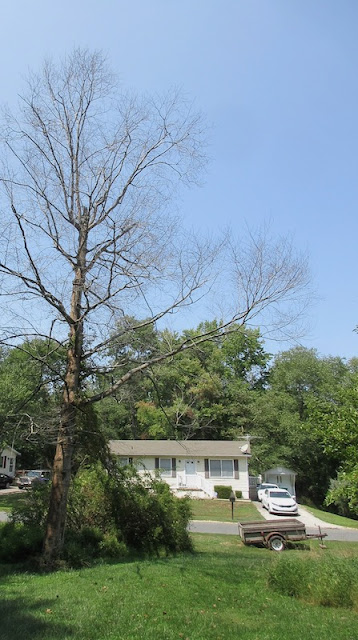The hot weather and drought has finally broken here. The last few days, the temperature has dropped and I have gotten almost 2" of rain. The lawn, tomatoes, and flowers sure appreciate it! Even the native wildflowers were struggling...
One good thing about the rain was that it fell in spurts over 3 days, so it all had a chance to soak in. It can be depressing to get 2" of rain all at once and watching the storm drains carrying most of it away!
The temperature wasn't as bad as some places. Ten days ago, it was this, though, and that was at 11:30 am. It probably got worse in the afternoon.
Temperature is a funny thing though. I read a science article in the newspaper that said even accounting for the "heat index", a lower temperature in one region can be harsher than a higher temperature in another.
I don't recall all the details, but it involved accumulated soil temperature, sunlight reflectivity, etc. They gave specific examples, but basically sometimes 100 is worse than 105. Old joke "It was so hot, I saw a starving coyote chasing a terrified rabbit. And they were both walking!"
And as far as "plain old temperature" goes, I was in Ft Worth TX on Govt business once, and walking to lunch with a few local employees. We passed a bank temperature/time display and I laughed, saying they should get their display fixed. It said 110 and I was comfortable enough. One of the local guys glanced at it and said it looked right. Huh???
It was the low humidity (about 10-20% he said). Wow, I am used to 60-80% humidity in July. That sure makes a difference.
Three decades ago here, we would get several days each Summer over 100 and a lot of high 90s. The lawn would get so hot and dry that the soil would crack open. The grass was routinely brown July and August. It hasn't been that bad for many years.
It may be that my lawn soil and grass is much better than when I first moved here (to an undeveloped property). The builder probably seeded it with really cheap grass and used cheap "fill dirt" to raise and level the lawn (and then drove heavy equipment all over it building the house).
One good organic lawn practice is to leave your grass clippings on the lawn. Grass is the perfect fertilizer for grass. By definition, grass clippings have exactly what grass needs. And, no, it doesn't cause "thatch". Thatch is a layer of dead and living surface grass roots, and from runners from grasses that spread outwards (bluegrass, bermuda, and bent). I have been overseeing with fescue for 3 decades.
I don't want to get too far "into the weeds" here and bore you to death. But causes of thatch include over-fertilization, frequent shallow watering (it brings roots to the surface), and poor and/or compacted soil.
And let some clover grow in your lawn. First, the bees will love you for it! But maybe more importantly, clover roots grow deeper than grass roots. They bring nutrients back up from deeper soil. Those nutrients are stored in the clover leaves. Then, those nutrients are returned to the surface of the lawn, where the grass roots can get at them when you mow the lawn.
Over the years, the cycle of nutrient replenishment and left-in-place organic matter improves even bad soil. I can tell. I planted a shrub and a tree sapling in the front yard last Fall. When I looked at the holes, I could see that the top 3" were darker and richer than the soil below. It used to be clay from the surface down...
Meanwhile, I am enjoying the cooler and rainier days this past week. Usually, this week or two are the hottest and driest part of the year. But the forecasts show a decent chance of rain most days for the next 2 weeks. I sure hope they are accurate!



